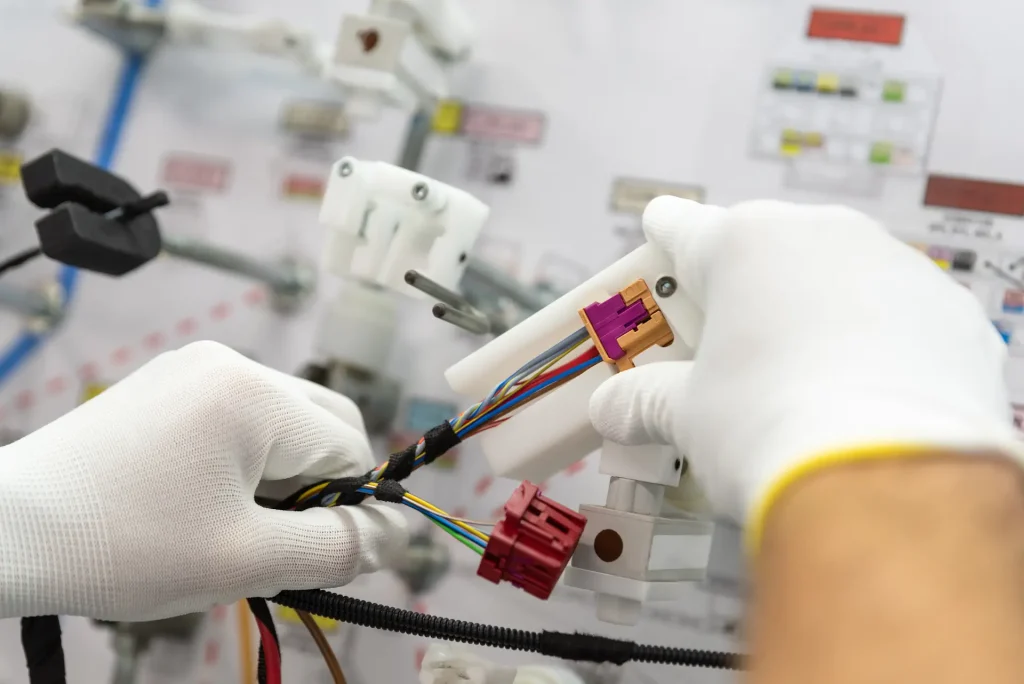What Are Cable Assemblies?
What are cable assemblies—often called wire harnesses, wiring harnesses, wiring looms, or cable harnesses—and why do they matter so much? These components form the core of modern technology by enabling smooth data transfer and consistent power flow. Far from being ordinary wires, they’re meticulously built to withstand everything from typical household use to the punishing conditions of heavy industry.
Everyday Importance: Reliable Connections for Daily Devices
It may be surprising how integral cable assemblies are in our day-to-day life. They keep your phone charged, your computer powered, and your appliances running smoothly. Within each assembly, multiple wires and connectors work together to preserve a steady flow of power or data. Even a minor malfunction in a critical setting—like a factory’s production line—can lead to major disruptions. Solid cable assemblies avert such hazards by maintaining reliable connections.
Common Varieties and Ideal Uses
A common type of cable assembly that you should be familiar with is coaxial cables. Coaxial cables excel at delivering clear signals for broadcast purposes. Another common cable assembly is fiber optics which move massive amounts of data at the speed of light and are perfect for cutting-edge communication systems. Some cable assemblies are built to survive punishing environments, like underwater or in outer space, ensuring connectivity remains constant no matter where it’s needed.
Beyond Ordinary Cables: Defining Cable Assemblies
Cable assemblies differ from standard wiring because they are precisely designed for unique applications, often with specialized coverings or insulating layers. As technology advances—demanding quicker data speeds and stricter environmental safeguards—these assemblies adapt through upgraded materials, improved shielding, and greener manufacturing methods. The emphasis is on delivering high performance while minimizing energy loss or system vulnerabilities.
Core Components: Conductors, Insulators, and Connectors
Each cable assembly is a carefully orchestrated system of conductors, insulators, and connectors. Conductors, typically made of copper or high-quality alloys, transmit signals or electrical current with minimal resistance. Insulators, featuring robust polymers, shield these signals from external interference. Connectors complete the puzzle by linking everything together, ensuring signals flow smoothly from one device to the next.
Material Quality: A Crucial Factor for Performance and Longevity
When cable assemblies use premium alloys and durable insulating materials, the payoff is increased reliability and a longer working life. Cheap materials, on the other hand, degrade or fail faster, leading to unexpected service calls and replacements. Investing in top-tier components saves both time and resources in the long run, especially in demanding environments.
Design and Production: From Concept to Finished Product
The design and production of cable assemblies begins with engineers identifying the specific requirements of the end application: voltage, signal type, environmental factors, and more. Based on these needs, they map out the wires, connectors, and protective layers. Cable assembly manufacturers have automation in place that handles tasks like cutting, stripping, or crimping cables, but human oversight is critical to ensure each detail meets rigorous standards. The final product emerges as a cohesive unit, ready for real-world use.
Testing and Quality Control: Ensuring Real-World Reliability
Before cable assemblies reach customers, they undergo thorough evaluations. Strain tests measure how well assemblies endure pulling forces, while thermal cycling simulates extreme temperatures. Additional tests, such as insulation resistance checks, confirm signal integrity without leaks or short circuits. These protocols guarantee that what leaves the production line can handle the rigors of its intended environment.
Diverse Applications: Matching Assemblies to Specific Needs
Some assemblies cater to high-frequency data transfer, while others are built for durability in rugged climates. Coaxial assemblies excel in television and radio systems, fiber optic assemblies provide lightning-fast speeds for telecommunications, and medical-grade assemblies must remain sterile and reliable for healthcare devices. Each variant addresses distinct challenges with specialized designs and protective measures.
Quality, Safety, and Industry Standards
Safety and consistency are paramount for cable assemblies. Common certifications and standards include:
- UL (Underwriters Laboratories): Confirms adherence to safety and flammability benchmarks.
- RoHS (Restriction of Hazardous Substances): Limits hazardous materials in electronic components.
- IEC (International Electrotechnical Commission): Establishes global testing and performance guidelines.
- IPC/WHMA-A-620: Defines quality and acceptability requirements for wire harness assemblies.
- ISO 9001: Addresses overall quality management systems, ensuring continuous improvement.
Meeting or exceeding these standards indicates that a manufacturer prioritizes both performance and user safety. Products that align with industry benchmarks generally feature precision components, robust insulation, and proven reliability.
Advanced Protective Features: Shielding and Specialized Jackets
Many assemblies incorporate shielding layers or tough outer jackets. These elements block electromagnetic interference and protect the cable from environmental hazards like moisture or chemicals. In more extreme settings—such as aerospace or defense—additional safeguards like fire-resistant materials or strain-relief features help the assemblies survive constant motion and extreme vibration.
Avoiding Pitfalls: Common Mistakes When Choosing Cable Assemblies
Overlooking voltage requirements or ignoring the operational environment can result in poor performance and frequent breakdowns. Failing to plan for future needs may also mean that an assembly quickly becomes outdated as technology advances. Thorough planning ensures that the selected assembly remains reliable and functional over its entire lifecycle.
In Action: Major Industries That Depend on Cable Assemblies
Cable assemblies stand at the heart of industries such as automotive, where they manage everything from engine systems to infotainment. In aerospace, they withstand intense forces and temperature variations. Defense and industrial automation sectors likewise depend on high-quality assemblies to guarantee safe, uninterrupted operation. Even in everyday settings, the difference between a dependable assembly and a low-quality wire can be huge.
Sustainability and Future Trends
The drive toward sustainability pushes manufacturers to explore lighter conductors, biodegradable insulation, and more energy-efficient production. As homes and workplaces become smarter, cable assemblies must handle higher data loads with enhanced durability and flexibility. Balancing performance and environmental stewardship will define the next generation of designs, ensuring that these critical connections continue to evolve responsibly.
Safeguarding Tomorrow’s Technology with Cable Assemblies
Cable assemblies serve as the bedrock of modern electronics, quietly managing power and data so the world remains seamlessly connected. By adhering to recognized standards, utilizing premium materials, and planning for future demands, we can ensure cable assemblies continue to support and advance the technologies we rely on every day.
Carrio Cabling is a Premier US Manufacturer of Cable Assemblies. If you have a need for custom cable assemblies, contact us for information on our capabilities and a price quote.



